Effect of Local Laser Treatment on the Strengthening of Thin-Walled Structures Fabricated from Non-Alloy Steel
Abstract
1. Introduction
1.1. Overview of Microstructure Formation Features of Non-Alloy Steels
1.2. Overview of the Features of Processing Non-Alloy Steels
2. Materials and Methods
3. Research Methodology
3.1. Laser Surface Treatment
3.2. Studying the Kinetics of Phase Transformations in Steels Using Austenite Decomposition Diagrams
3.3. Experimental Methods of Investigation of the Materials’ Properties and Microstructure
- “Standard” acid etchant complex based on a combination of picric and nital [46]: Reagent 1—2.4% solution of picric acid in ethanol; Reagent 2—1.4% solution of nitric acid in ethanol. The sample was sequentially etched for 2 s in Reagent 1 and up to 10 s in Reagent 2. Picric is considered to be the best acid etchant for revealing the structure of ferrite, pearlite, or dispersed varieties of pearlite and bainite in low-carbon steels. Etching steels with this method colours the structures of sorbite and troostite in brown or tan, martensite in blue, and austenite in a pale orange.
- “Tint” colour etchant based on sodium metabisulfite was used [47]: Reagent 1—4% solution of picric acid in ethanol (4 g dry picric acid/100 mL ethanol); Reagent 2—aqueous solution of sodium bisulfite (1 g Na2S2O5/100 mL distilled water). The sample surface was pre-etched with Reagent 1 (4% picric) for 15 s. After pre-etching, the specimen was etched with Reagent 2 for 15 s. The sample was oscillated during the entire pre-etching and etching stages. After each stage, the sample surface was washed with water and ethanol and dried in warm air. Aqueous sodium metabisulfite is an effective colour etchant for mixed microstructures because it reveals ferrite grain boundaries, pearlite or dispersed varieties of pearlite, bainite, and martensite. Etching steel samples using this method colours the structures of sorbite and troostite in brown or tan, bainite in blue, martensite in light brown, ferrite in white, and austenite in tin white.
- “Tint” colour etchant based on sodium thiosulfate [48]:Reagent 1—4% solution of picric acid in ethanol (4 g dry picric acid/100 mL ethanol); Reagent 2—10 g Na2S2O3 and 3 g K2S2O5/100 mL distilled water.The sample surface was pre-etched with Reagent 1 for 15 s. After pre-etching, the specimen was etched with Reagent 2 for 30 s under constant oscillation. This method of etching steels colours the structures of lower bainite in blue and grey, martensite in light brown, and cementite in white.
3.4. Simulation of Thermal Cycles during Laser Welding
3.5. FEA Simulation of Tension and Bending of Thin Metal Plate
4. Research Results
4.1. Results of the Structural Analysis of the Laser-Processed Surface Layer
4.2. Results of Analysis of Phase Transformation Kinetics in Steels Using Austenite Decomposition Diagrams
4.3. Results of Heat Transfer Modelling during Laser Treatment
4.4. Results of the FEA Simulations of the Bending and Tension of the Laser-Processed Samples
4.5. Results of the Mechanical Testing of the Laser-Processed Samples
4.6. Comparison of the Experimental and Modelling Results
5. Conclusions
Author Contributions
Funding
Institutional Review Board Statement
Informed Consent Statement
Data Availability Statement
Acknowledgments
Conflicts of Interest
References
- Kapustynskyi, O.; Višniakov, N. Laser treatment for strengthening of thin sheet steel. Adv. Mater. Sci. Eng. 2020, 2020, 5963012. [Google Scholar] [CrossRef]
- Kapustynskyi, O.; Višniakov, N.; Zabulionis, D.; Piščalov, A. Feasibility evaluation of local laser treatment for strengthening of thin-walled structures from low-carbon steel subjected to bending. Materials 2020, 13, 3085. [Google Scholar] [CrossRef]
- Kapustynskyi, O.; Višniakov, N.; Černašėjus, O.; Golovko, L.; Chayeuski, V. Optimization of the Parameters of Local Laser Treatment for the Creation of Reinforcing Ribs in Thin Metal Sheets. In Proceedings of the 24th International Conference “Mechanika 2019”, Kaunas, Lithuania, 17 May 2019; pp. 71–75. [Google Scholar]
- Frolova, O.S. Material Science; Reference Book; Sakhalin State University: Yuzhno-Sakhalinsk, Russia, 2016; p. 84. (In Russian) [Google Scholar]
- Chiudina, O.V.; Gladova, G.V.; Ostrouch, A.V. Theory and Practice of Heat Treatment of Metals; Reference book; Moscow Automobile and Road Construction State Technical University (MADI): Moscow, Russia, 2013; p. 64. (In Russian) [Google Scholar]
- Kozvonin, V.A. Formation of an Ultrafine-Crystalline Structure and the Required Physical and Mechanical Properties of Iron-Based Alloys for Instrumentation. Ph.D. Thesis, Perm National Research Polytechnic University, Perm, Russia, 2017; p. 146. (In Russian). [Google Scholar]
- Kuklina, A.A. Computational and Experimental Kinetics of Bainitic Transformation of Medium-Carbon Structural Steels under Isothermal Conditions and during Continuous Cooling. Ph.D. Thesis, Ural Federal University, Yekaterinburg, Russia, 2018; p. 125. (In Russian). [Google Scholar]
- Davidova, I.S.; Maksina, J.L. Material Science; Reference Book; Infra-M: Moscow, Russia, 2006; p. 240. (In Russian) [Google Scholar]
- Aleksandrov, V.M. Materials and Technology of Structural Materials; Reference book; Part 1; Northern (Arctic) Federal University: Arkhangelsk, Russia, 2015; p. 327. (In Russian) [Google Scholar]
- Gulyaev, A.P. Metal Science; Metallurgiya: Moscow, Russia, 1986; p. 544. (In Russian) [Google Scholar]
- Natapov, B.S. Thermal Treatment of Metals; Kiev, High School: Kiev, Ukraine, 1980; p. 282. (In Russian) [Google Scholar]
- Bogoduchov, S.I.; Kozik, E.S. Materials Science; Reference Book; Orenburg State University: Orenburg, Russia, 2011; p. 670. (In Russian) [Google Scholar]
- Kozlovskij, A.E.; Kolobov, M.J. Heat Treatment of Carbon Steels; Reference Book; Ivanovo State University of Chemical Technology: Ivanovo, Russia, 2017; p. 143. (In Russian) [Google Scholar]
- Maniruzzaman, M.; Wang, X.; Sisson, R.D. Normalizing of steel. In Steel Heat Treating Fundamentals and Processes; Dossett, J.L., Totten, G.E., Eds.; ASM Handbook; ASM International: Almere, The Netherlands, 2013; Volume 4A, pp. 280–288. [Google Scholar]
- Kucher, A.M. Technology of Metals, 4th ed.; Mashinostrojenije: Leningrad, Russia, 1987; p. 214. (In Russian) [Google Scholar]
- Pertash, L.V. Quenching Mediums; Mashgiz: Moscow, Russia, 1959; p. 113. (In Russian) [Google Scholar]
- Schneider, M.J.; Chatterjee, M.S. Introduction to surface hardening of steels. In Steel Heat Treating Fundamentals and Processes; Dossett, J.L., Totten, G.E., Eds.; ASM Handbook; ASM International: Almere, The Netherlands, 2013; Volume 4A, pp. 389–398. [Google Scholar]
- Fuller, A.J., Jr. Introduction to carburising and carbonitriding. In Steel Heat Treating Fundamentals and Processes; Dossett, J.L., Totten, G.E., Eds.; ASM Handbook; ASM International: Almere, The Netherlands, 2013; Volume 4A, pp. 505–521. [Google Scholar]
- Mittemeijer, E.J. Nitriding and nitrocarburising of steel. In Steel Heat Treating Fundamentals and Processes; Dossett, J.L., Totten, G.E., Eds.; ASM Handbook; ASM International: Almere, The Netherlands, 2013; Volume 4A, pp. 617–701. [Google Scholar]
- Zimmerman, C. Diffusion coating. In Steel Heat Treating Fundamentals and Processes; Dossett, J.L., Totten, G.E., Eds.; ASM Handbook; ASM International: Almere, The Netherlands, 2013; Volume 4A, pp. 705–722. [Google Scholar]
- Davidian, L.V. Intensification of diffusive saturation of carbon and alloyed steels with boron during micro-arc heating. Ph.D. Thesis, Don State Technical University, Rostov-on-Don, Russia, 2019; p. 128. (In Russian). [Google Scholar]
- Stepankova, T.J. Technology of Surface Hardening of Machine Elements; Reference Book; Ivanovo State University of Chemical Technology: Ivanovo, Russia, 2009; p. 64. (In Russian) [Google Scholar]
- Furlani, M.R.; de Carvalho, S.M.; de Lima, M.S.F. Effect of laser surface hardening on a low carbon steel substrate wear and hardness. arXiv 2021, arXiv:2111.13183. [Google Scholar]
- Ion, J.C. Laser Transformation Hardening. Surf. Eng. 2002, 18, 14–31. [Google Scholar] [CrossRef]
- Höche, D.; Kaspar, J.; Schaaf, P. Laser nitriding and carburisation of materials. In Laser Surface Engineering: Processes and Applications; Woodhead Publishing, Elsevier: Cambridge, UK, 2015; pp. 33–58. [Google Scholar]
- Nath, A.K.; Sarkar, S. Laser Transformation Hardening of Steel. In Advances in Laser Materials Processing, 2nd ed.; Woodhead Publishing, Elsevier: Cambridge, UK, 2018; pp. 257–298. [Google Scholar]
- EN 10250-2:1999; Part 2: Non-Alloy Quality and Special Steels. CEN: Brussels, Belgium, 1999.
- Montealegre, M.A.; Castro, G.; Rey, P.; Arias, J.L.; Vazquez, P.; González, M. Surface treatments by laser technology. Contemp. Mater. 2010, 1, 19–30. [Google Scholar] [CrossRef]
- Klimkov, J.M.; Majorov, V.S.; Choroshev, M.V. Interaction of Laser Radiation with Matter; Reference Book; Moscow State University of Geodesy and Cartography: Moscow, Russia, 2014; p. 109. (In Russian) [Google Scholar]
- Višniakov, N.; Mikalauskas, G.; Černašėjus, O.; Škamat, J. Laser welding of copper-niobium microcomposite wires for pulsed power applications. Mater. Werkst. 2019, 50, 646–662. [Google Scholar] [CrossRef]
- Ion, J.C. Laser Processing of Engineering Materials; Elsevier: Amsterdam, The Netherlands, 2004; p. 589. [Google Scholar]
- Kovacs, T. Laser welding process specification based on welding theories. Procedia Manuf. 2018, 22, 147–153. [Google Scholar] [CrossRef]
- Taic, N.J. Theory of Steel Heating; Metalurgizdat: Moscow, Russia, 1950; p. 453. [Google Scholar]
- Smallman, R.E.; Ngan, A.H.W. Steel Transformations. In Modern Physical Metallurgy; Elsevier: Oxford, UK, 2014; pp. 473–498. [Google Scholar]
- Jegorov, G.V.; Jermolajev, G.V.; Kvasnickij, V.V.; Martinenko, V.A.; Matvijenko, M.V.; Kravcenko, L.P. Fundamentals of Welding Technology for Low-Alloy High-Strength Steels; Reference book; Admiral Makarov National University of Shipbuilding: Mykolaiv, Ukraine, 2014; p. 136. (In Russian) [Google Scholar]
- Gould, J.E.; Khurana, S.P.; Li, T. Predictions of Microstructures when welding automotive advanced high-strength steels. Weld. Res. 2006, 85, 111–116. [Google Scholar]
- Piekarska, W.; Goszczynska-Kroliszewska, D.; Saternus, Z.; Domanski, T.; Kubiak, M. Numerical analysis of laser welding with consideration analytical methods of determining phase transformations and mechanical properties of welded joint. In MATEC Web of Conferences; EDP Sciences: Les Ulis, France, 2018; Volume 157, p. 02039. [Google Scholar]
- Miettinen, J.; Louhenkilpi, S. Calculation of thermophysical properties of carbon and low alloyed steels for modelling of solidification processes. Metall. Mater. Trans. B 1994, 25, 909–916. [Google Scholar] [CrossRef]
- Kattner, U.R. The calpad method and its role in material and process development. Tecnol. Metal. Mater. Min. 2016, 13, 3. [Google Scholar] [CrossRef]
- Perrut, M. Thermodynamic Modelling by the Calpad Method and Its Applications to Innovative Materials. AerospaceLab J. 2015, 1–11. [Google Scholar] [CrossRef]
- JMatPro User’s Guide; Sentle Software Ltd.: Leicester, UK, 2005; p. 89.
- ISO 6892-1:2019; Metallic Materials—Tensile Testing—Part 1: Method of Test at Room Temperature. ISO: Geneva, Switzerland, 2019.
- ISO 6507-1:2018; Metallic Materials—Vickers Hardness Test—Part 1: Test Method. ISO: Geneva, Switzerland, 2018.
- ISO 7438:2016; Metallic Materials—Bend Test. ISO: Geneva, Switzerland, 2016.
- George, F. Vander Voort. In Etching Isothermally Treated Steels. Heat Treating Progress; Buehler Ltd.: Oak Harbor, OH, USA, 2001; p. 8. [Google Scholar]
- Gerasimova, L.P.; Guk, J.P. Practical Metallography; Infra-Inzheneriya: Moscow, Russia, 2017; p. 245. (In Russian) [Google Scholar]
- Zakerinia, H.; Kermanpur, A.; Najafizadeh, A. Color metallography: A suitable method for characterization of martensite and bainite in multiphase steels. Int. J. ISSI 2009, 6, 14–18. [Google Scholar]
- Mendonca, R.R.; Noguera, I.M.S.; Lovo, J.F.P.; Canale, L.C.P. Multiple etching methodology: Anew approach in multiphase steel characterization. J. Microsc. 2020, 227, 93–99. [Google Scholar] [CrossRef] [PubMed]
- Wagner, F. Applications of Mossbauer scattering techniques. J. Phys. 1976, 37, C6-673–C6-680. [Google Scholar] [CrossRef]
- Tadamalle, A.P.; Reddy, Y.P.; Ramjee, E.; Reddy, K.V. Estimation of weld pool geometry and cooling rate in laser welding. In Proceedings of the 5 International and 26 All India Manufacturing Technology, Design and Research Conference (AIMTDR 2014), Gurwahati, India, 12–14 December 2014; pp. 211-1–211-7. [Google Scholar]
- SmartWeld. Desktop Weld Optimization Software for Automated Welding. Sandia Corporation. 2011. Available online: http://smartweld.sourceforge.net/index.htm (accessed on 8 February 2022).
- Fuerschbach, P.W.; Eisler, G.R.; Steele, R.J. Weld Procedure Development with OSLW—Optimization Software for Laser Welding. In Proceedings of the Fifth International Conference on Trends in Welding Research, Pine Mountian, GA, USA, 1–5 June 1998; pp. 1–4. [Google Scholar]
- Kohnke, P. ANSYS Theory Reference; Release 5.6.; Ansys Inc.: Canonsburg, PA, USA, 1994; p. 1286. [Google Scholar]
- Dadkhah, F.; Zecher, J. ANSYS Workbench Software Tutorial with Multimedia CD; Release 12; SDC Publications: Mission, KS, USA, 2009; p. 256. Available online: https://www.sdcpublications.com/Textbooks/ANSYS-Workbench-Release-12-Software/ISBN/978-1-58503-581-6/Preview/ (accessed on 20 September 2022).
- FEA-CAE Engineering Analysis & Design. Available online: http://fea-cae-engineering.com/fea-cae-engineering/element_types.htm (accessed on 8 February 2022).
- ISO 643:2012; Steel—Micrographic Determination of the Apparent Grain Size. ISO: Geneva, Switzerland, 2012.
- Bkadeshia, H.; Honeycombe, R. Tempering of Martensite. In Steels: Microstructure and Properties, 4th ed.; Elsevier: Oxford, UK, 2017; pp. 237–270. [Google Scholar]
- Jianjun, H.; Wang, J.; Jiang, J.; Yang, X.; Hongbin, H.; Hui, l.; Guo, N. Effect of Heating Treatment on the Microstructure and Properties of Cr–Mo Duplex-Alloyed Coating Prepared by Double Glow Plasma Surface Alloying. Coatings 2019, 9, 336. [Google Scholar]
- Aronovich, M.; Lahtin, Y. Fundamentals of Metallurgy and Heat Treatment; Metallurgizdat: Moscow, Russia, 1952; p. 116. (In Russian) [Google Scholar]
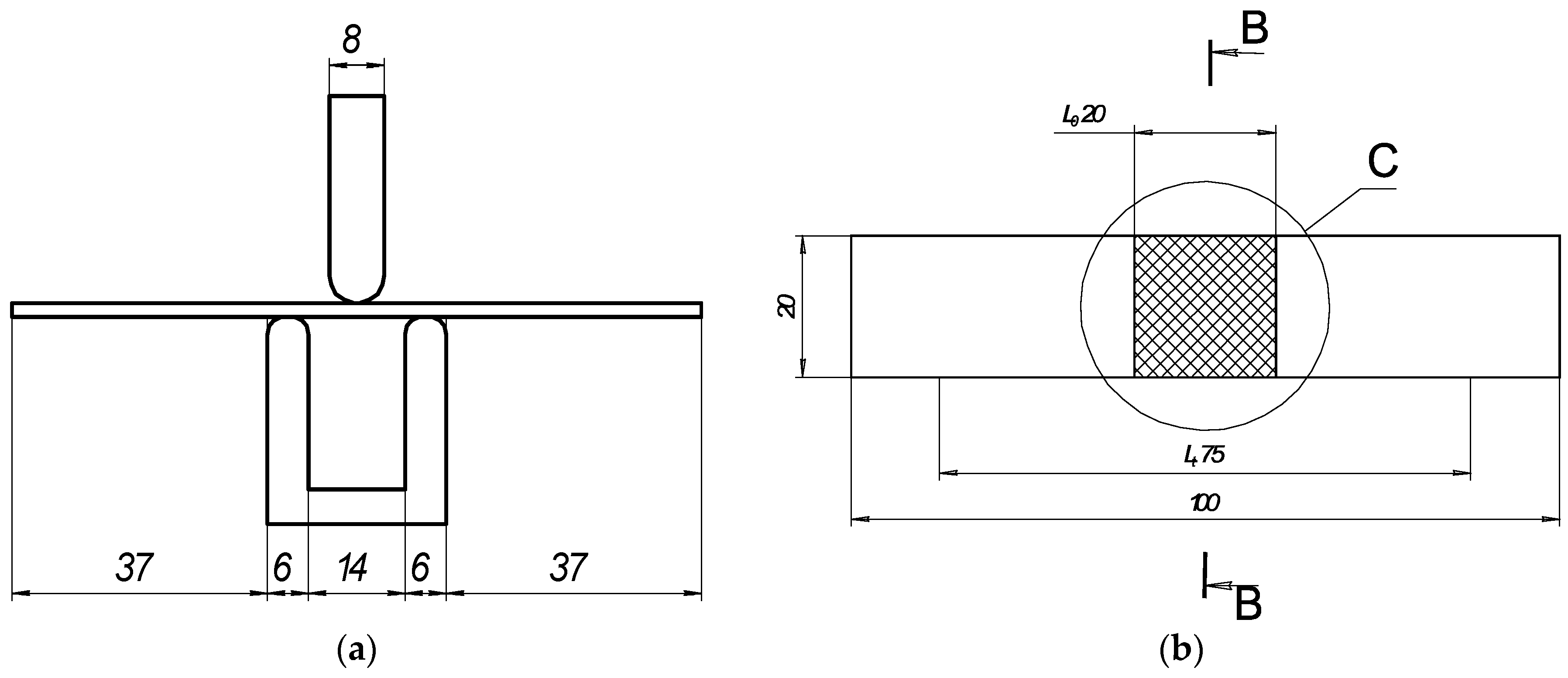

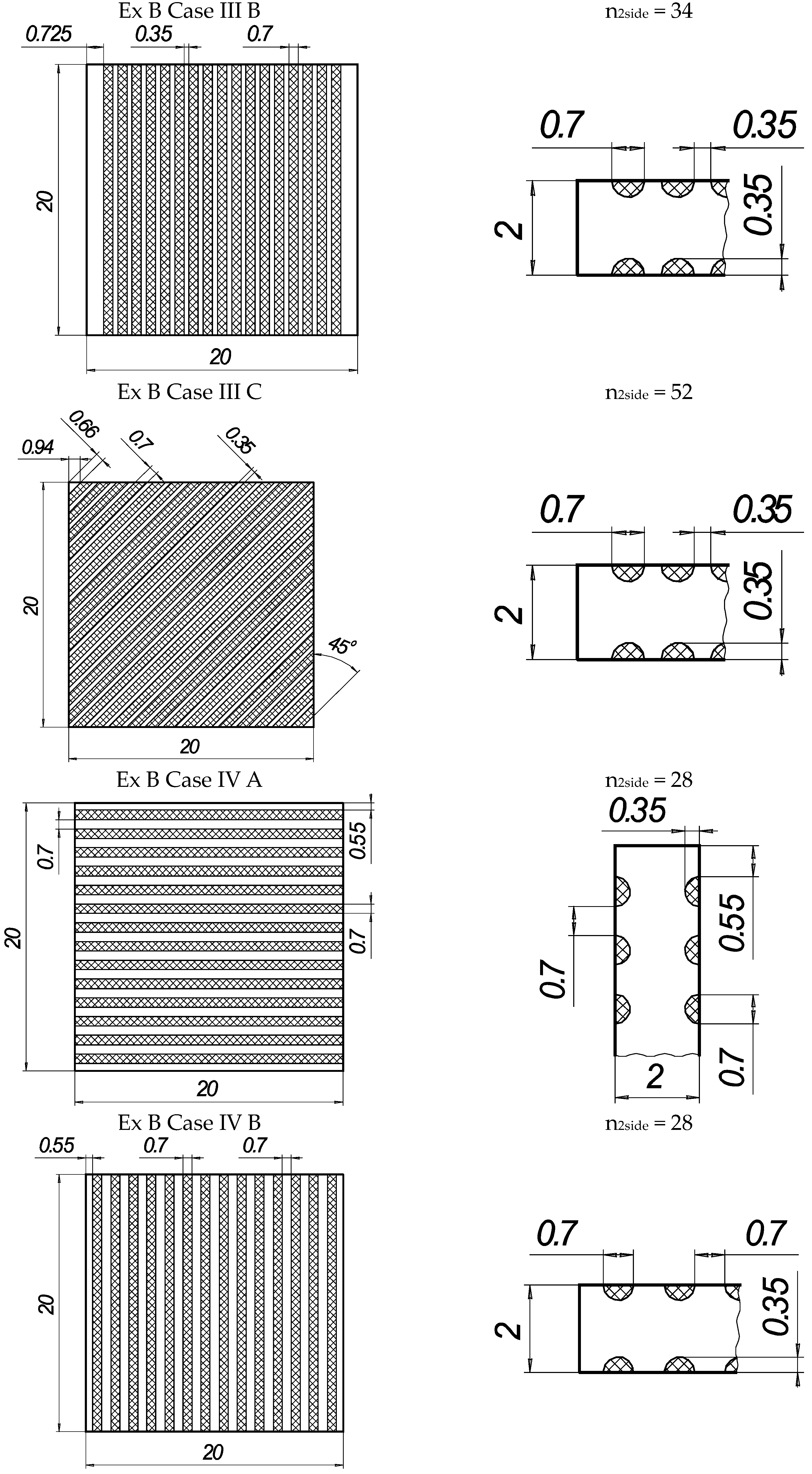

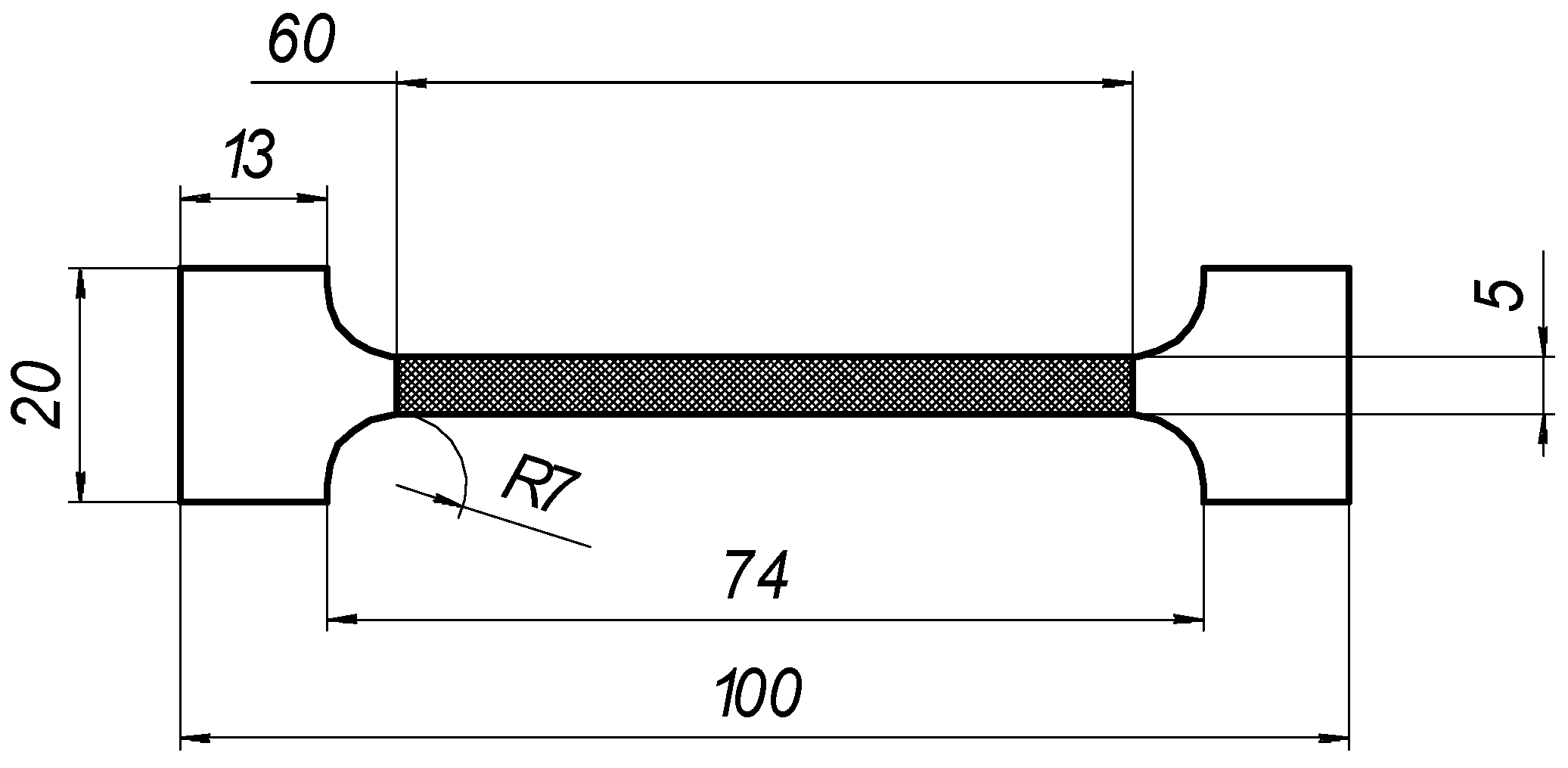

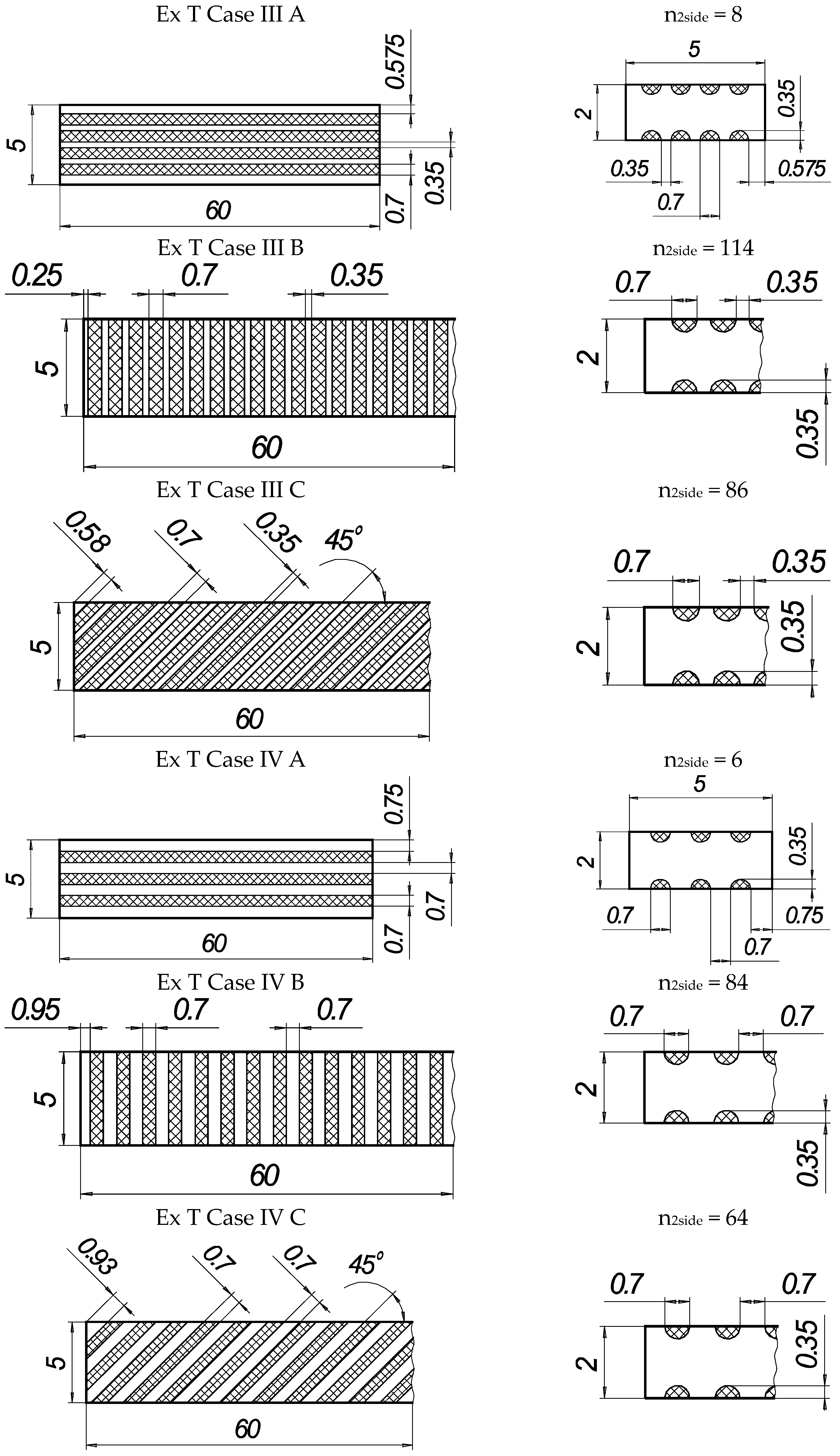
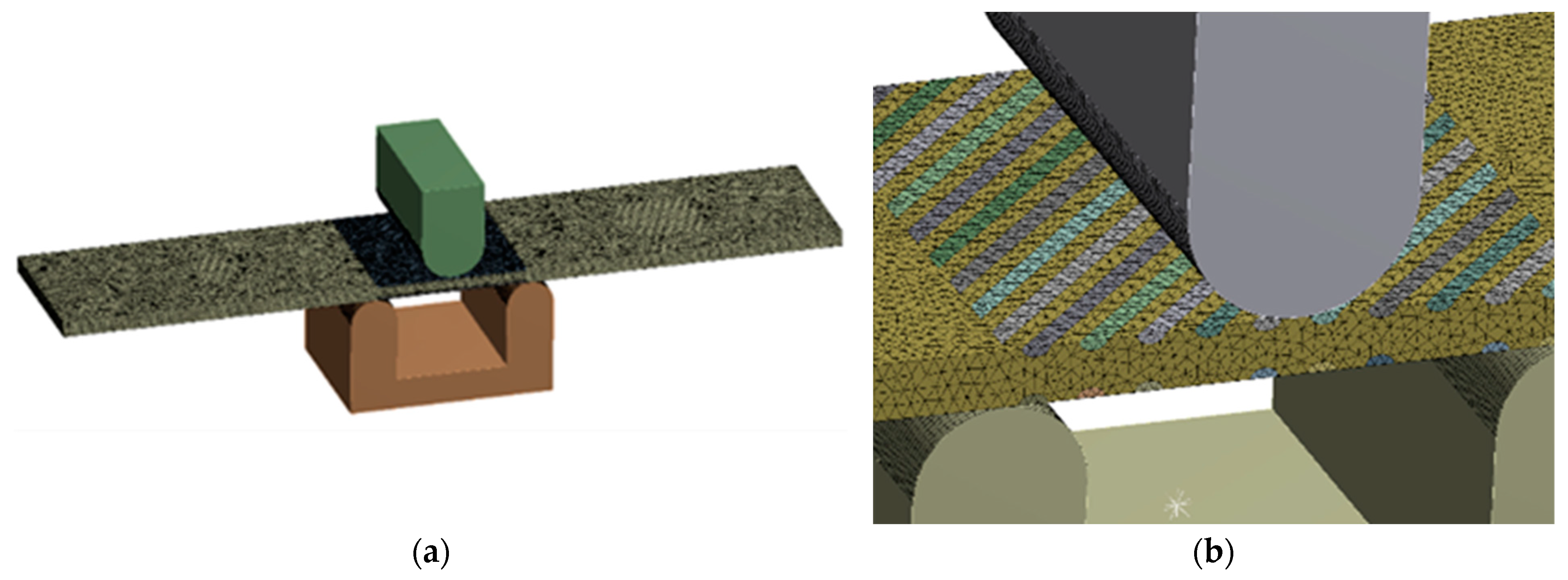
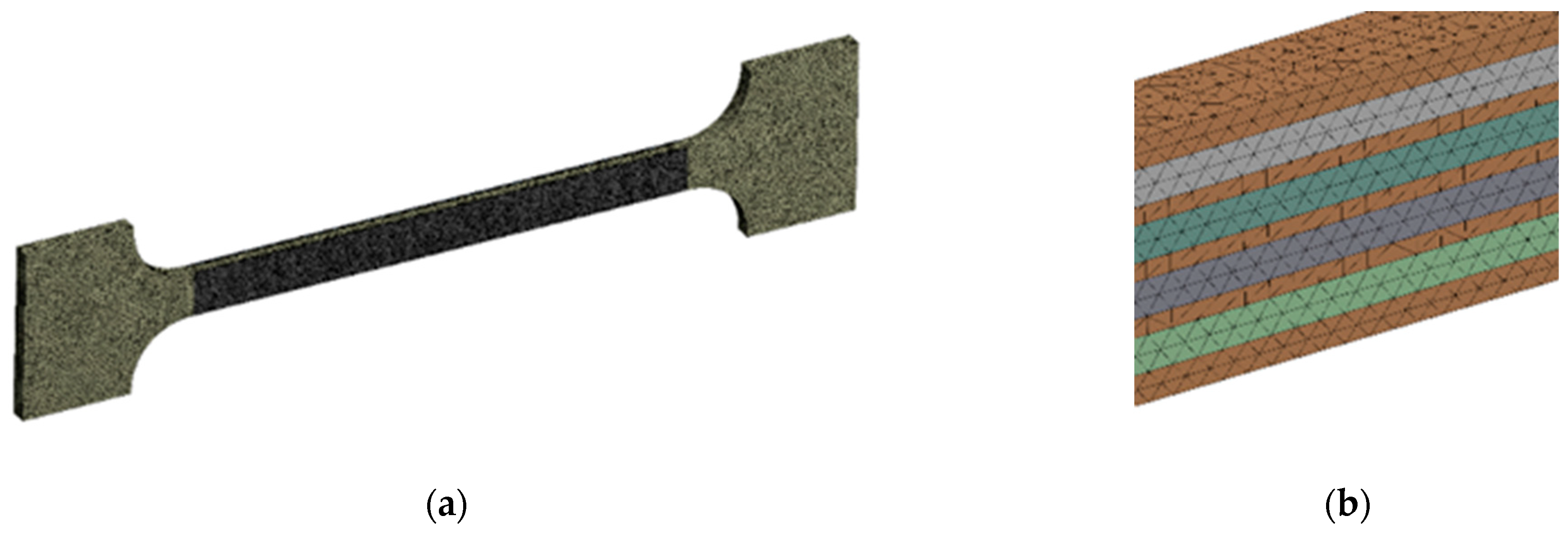
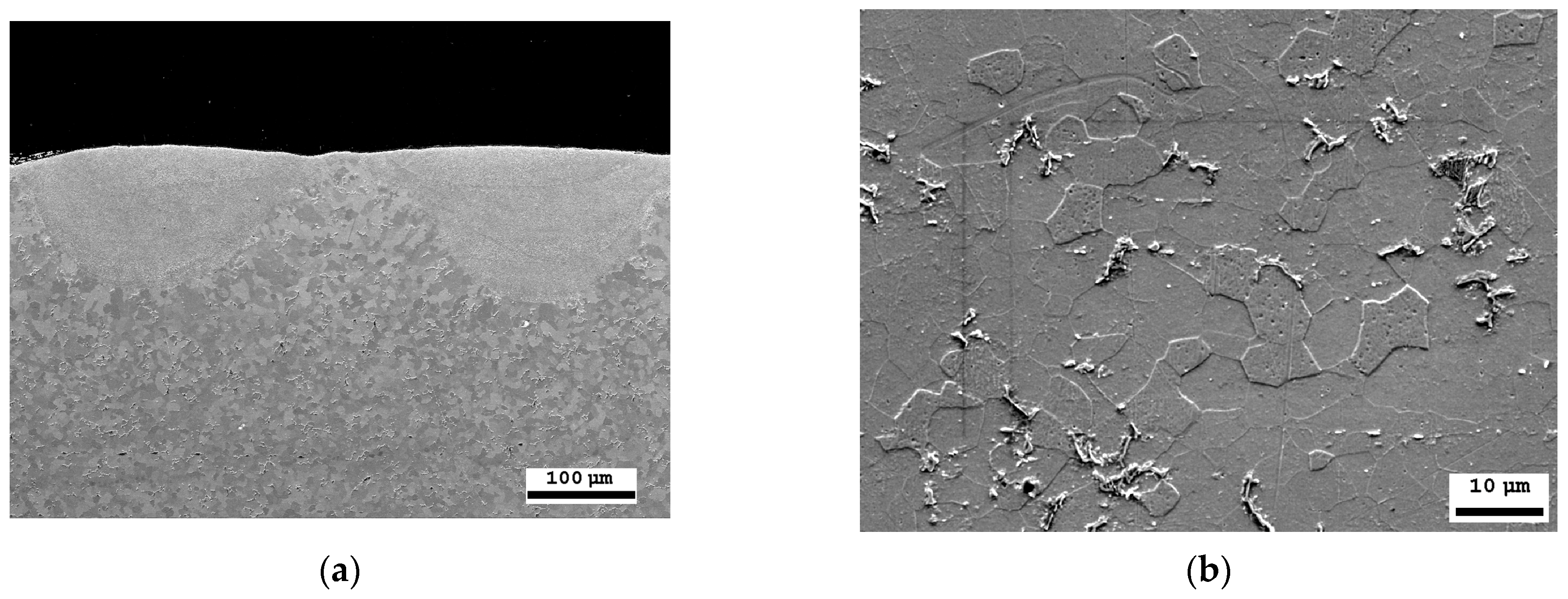
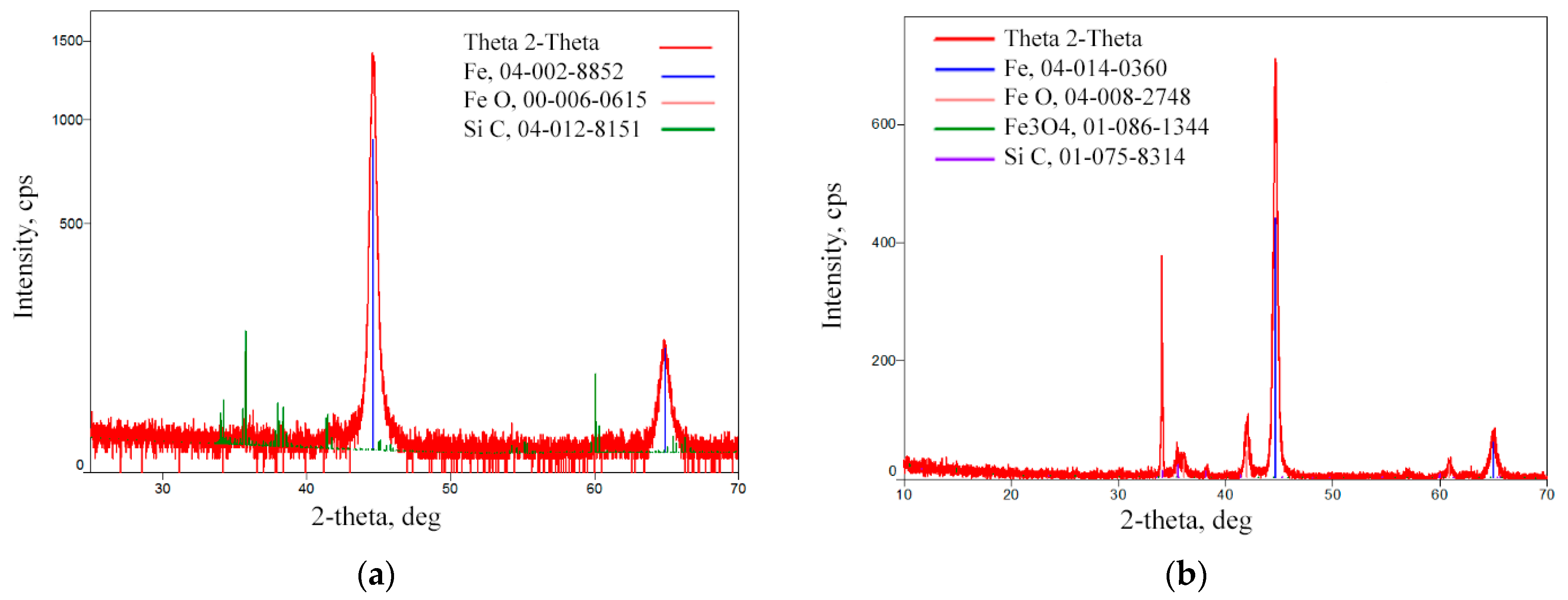
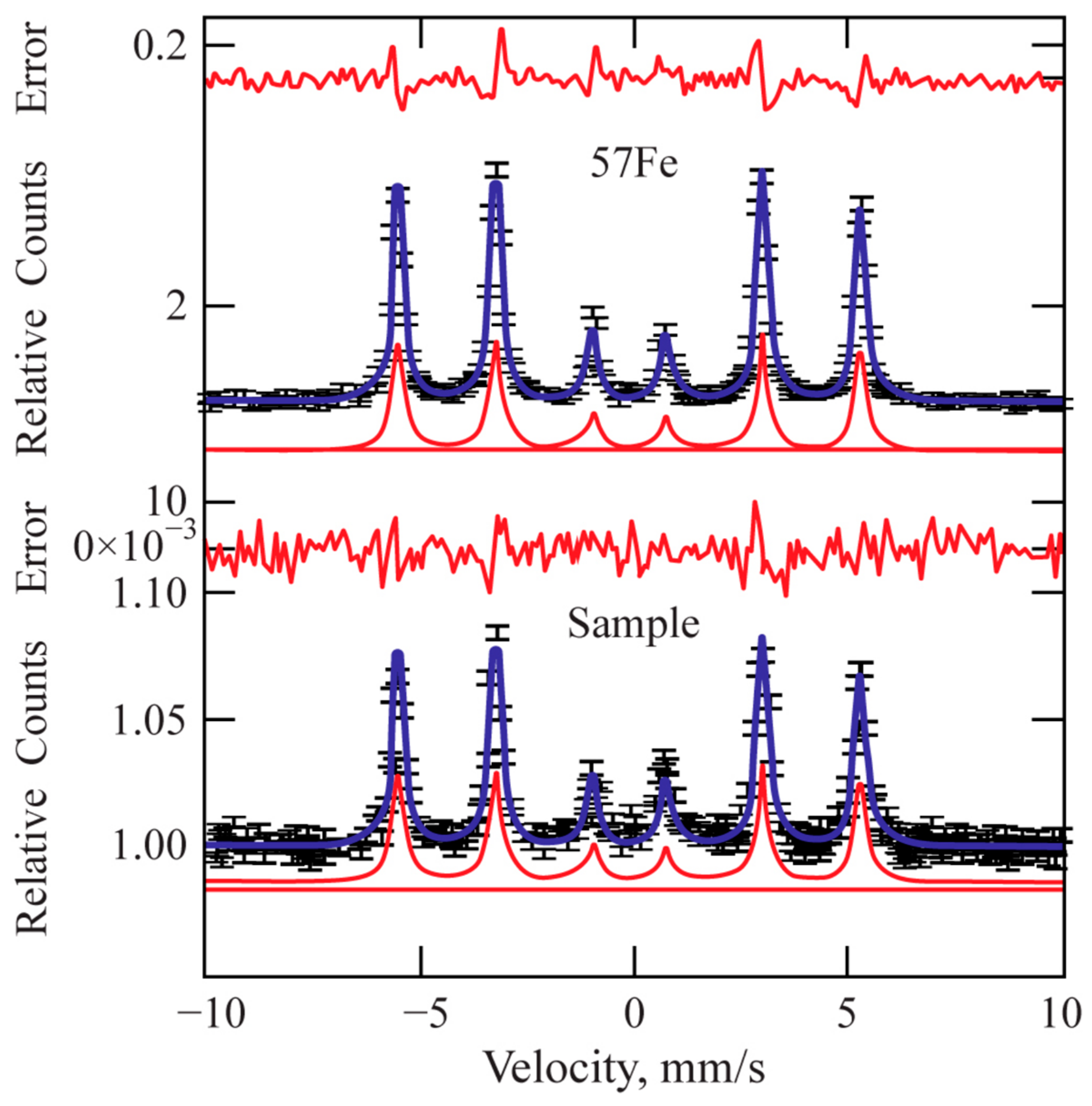
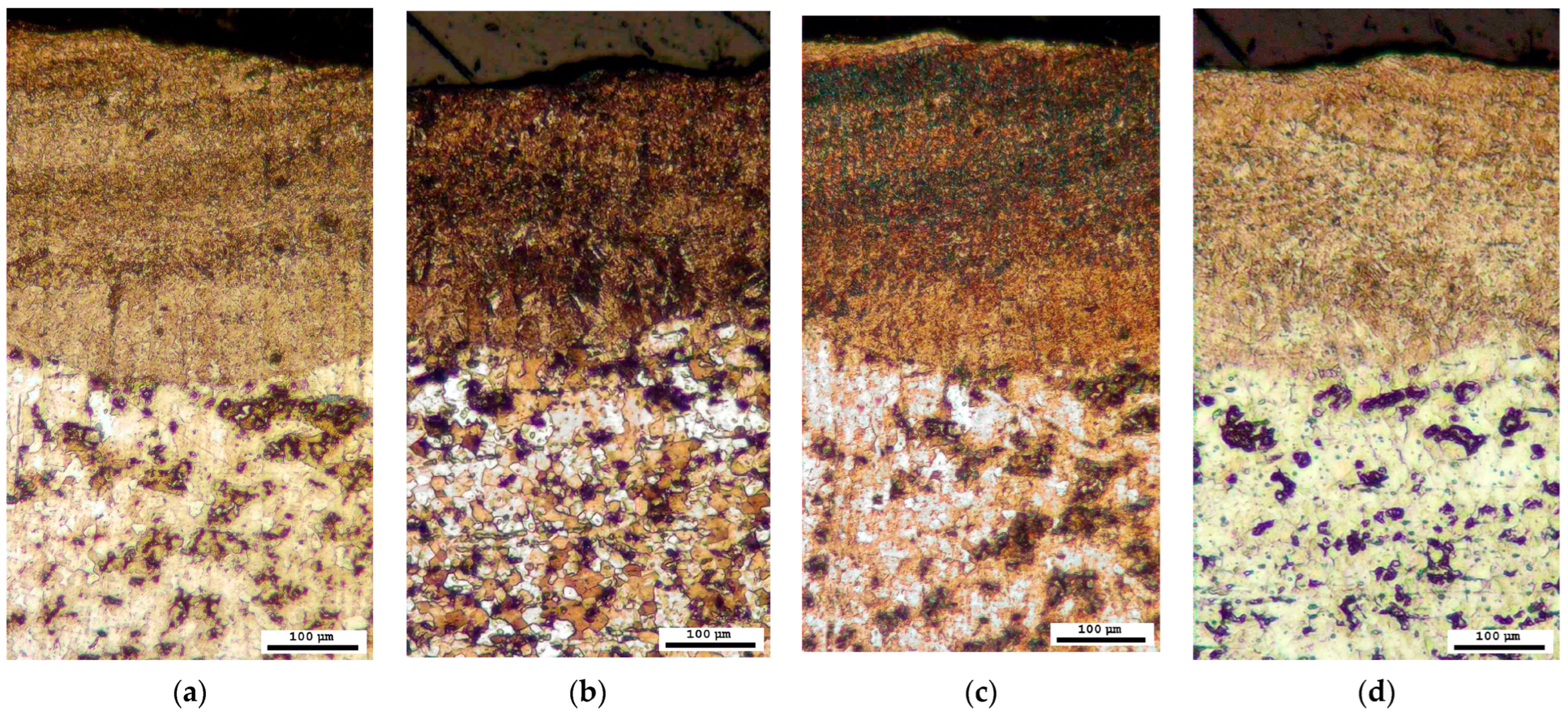
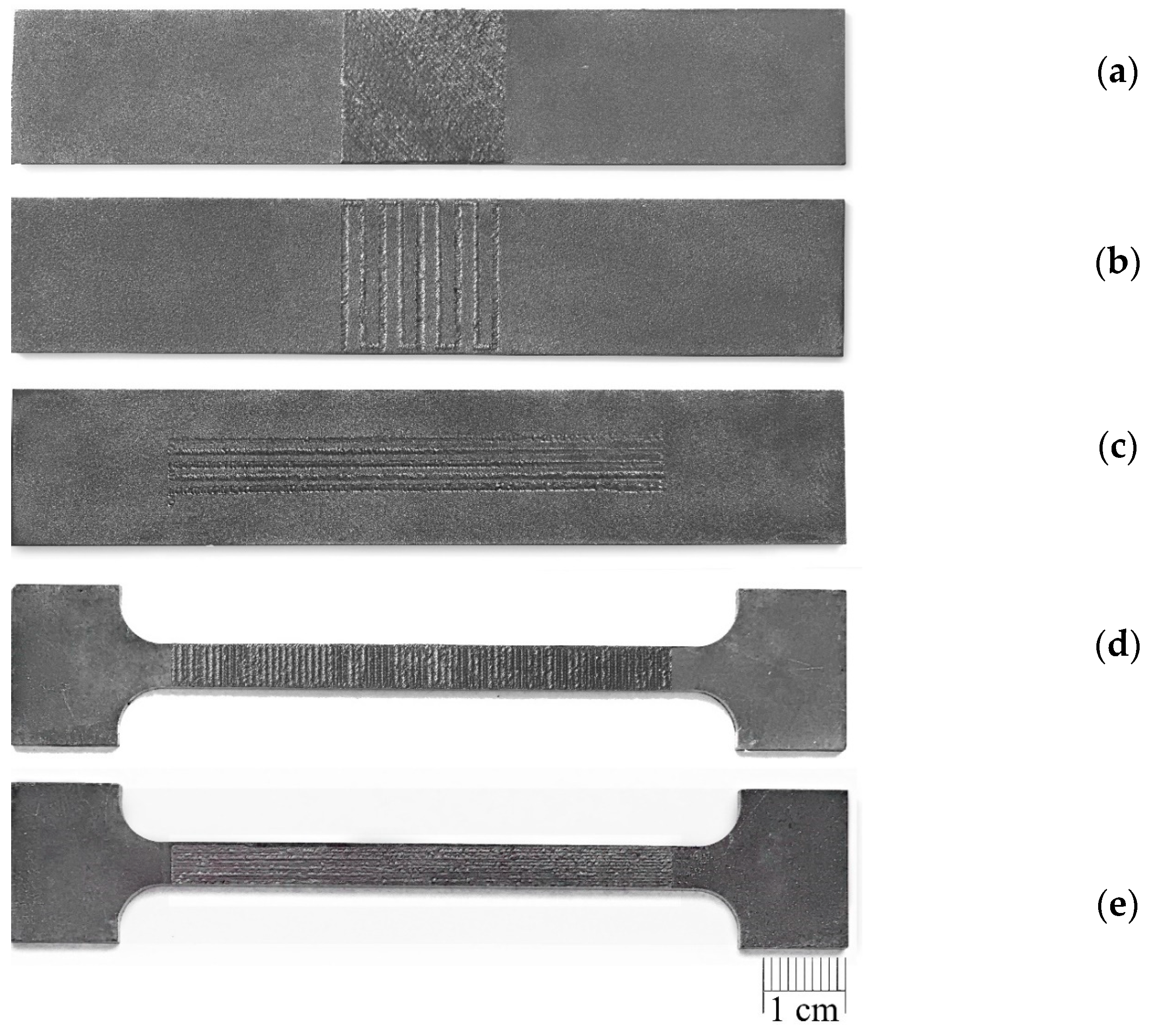
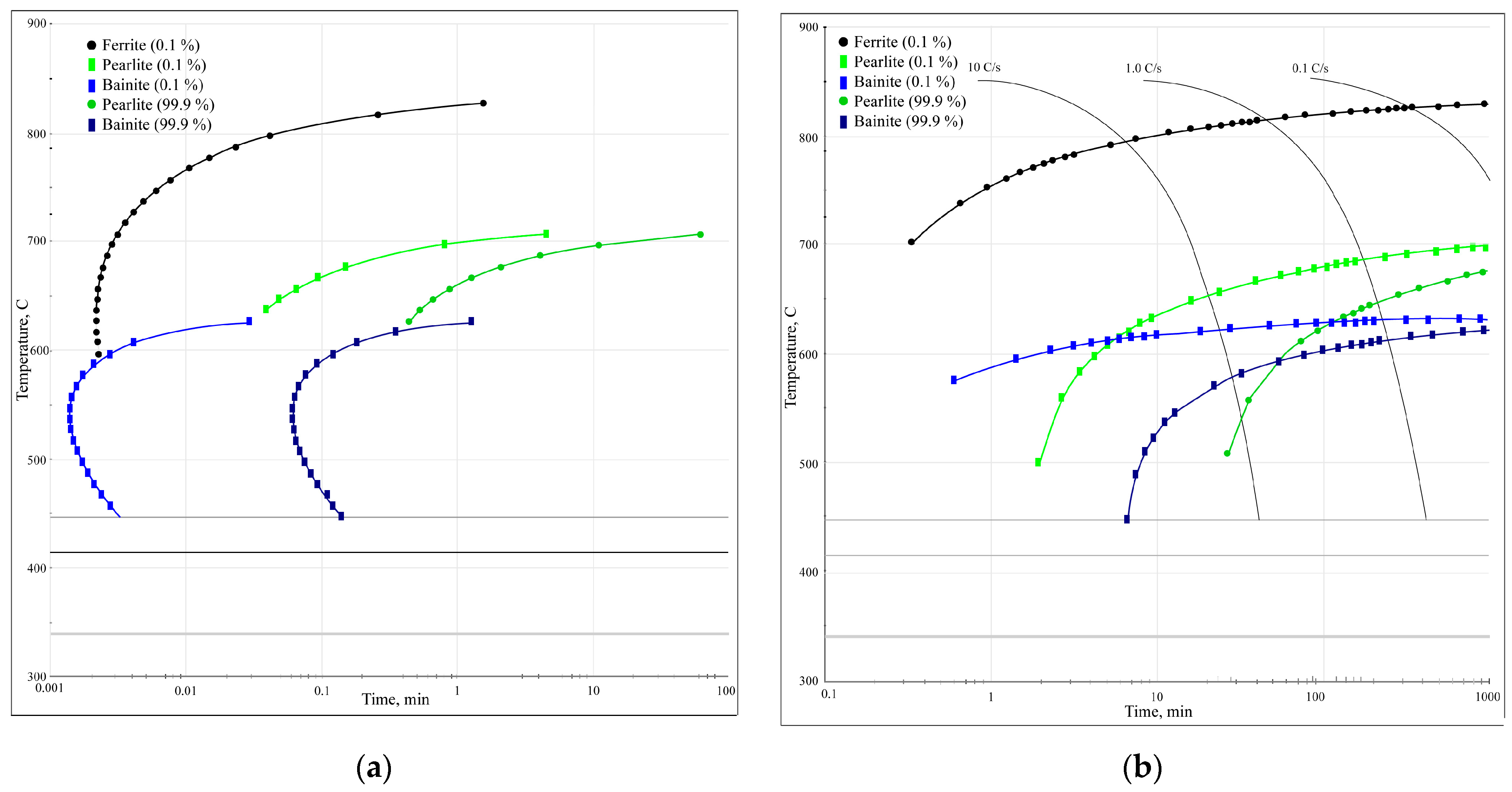



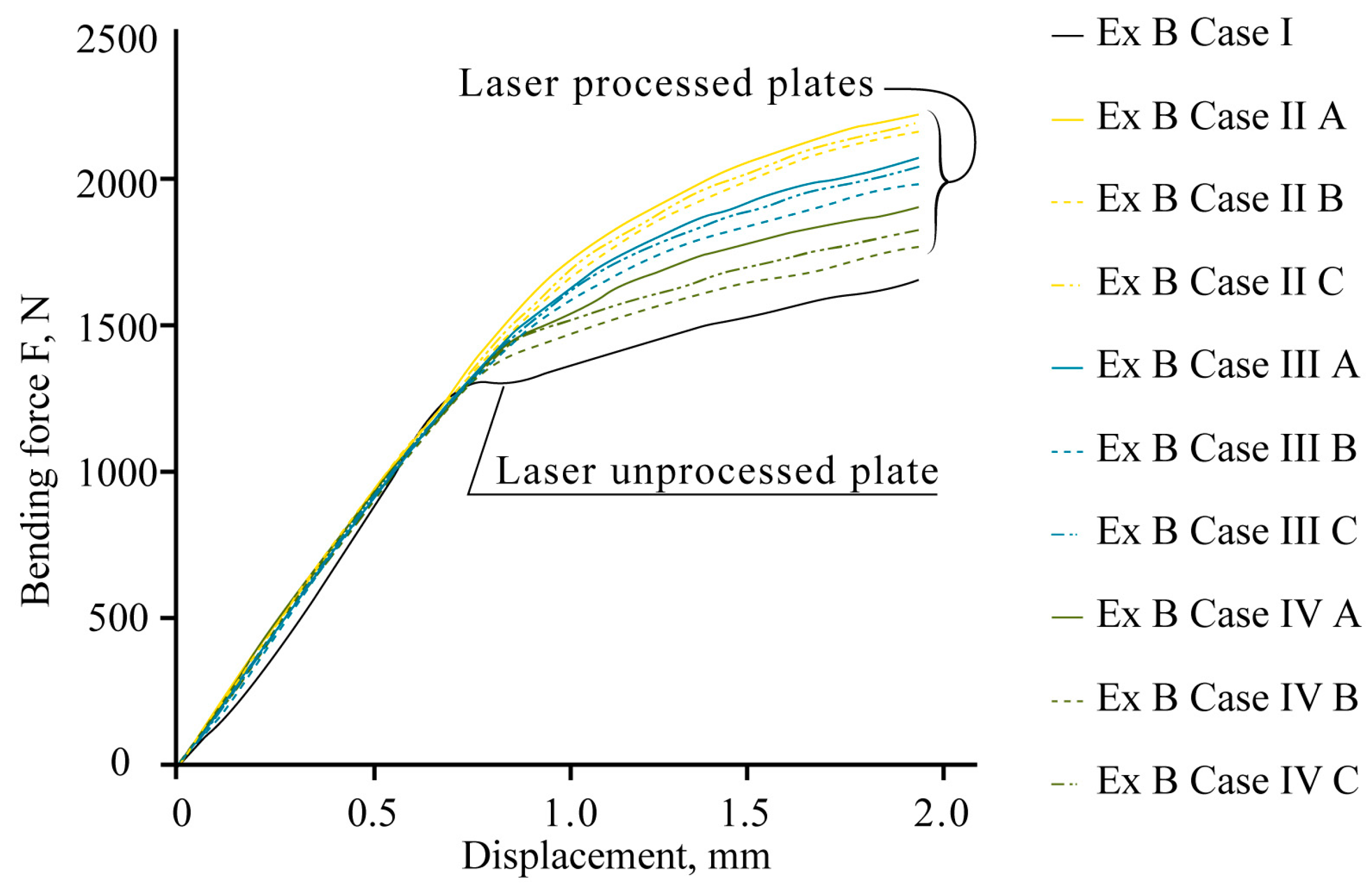
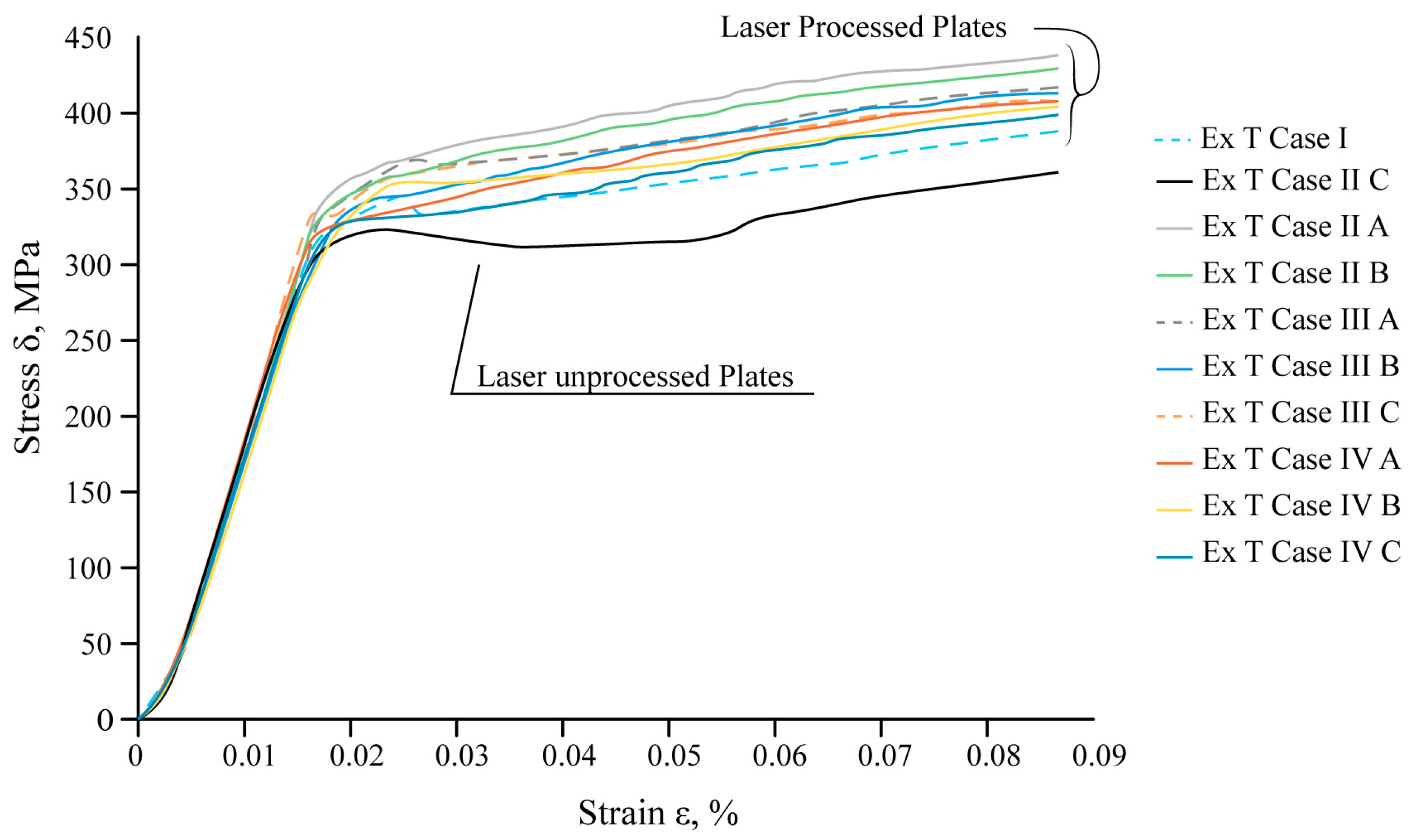
| Chemical Elements (wt%) | ||||||||
|---|---|---|---|---|---|---|---|---|
| C | Si | Mn | P | S | Cr | Mo | Ni | Fe |
| 0.18 | 0.18 | 0.45 | 0.02 | 0.02 | 0.05 | 0.01 | 0.07 | rest |
| Elastic Modulus E (GPa) | Yield Strength σ0.2 (MPa) | Tensile Strength σB (MPa) | Relative Extension A (%) | Hardness (HV) |
|---|---|---|---|---|
| 210 | 256 | 410 | 30 | 135 |
| Experiment Name | Number of Ribs (Total) | Overlay Coefficient of Laser Processing on the Sheet | Position and Stress–Strain State of the Laser-Treated Layer | Position of the Ribs |
|---|---|---|---|---|
| Ex B Case I | 0 | |||
| Ex B Case II A | 76 | Overlap | Double-sided | Horizontal |
| Ex B Case II B | 76 | Vertical | ||
| Ex B Case II C | 108 | 45 degrees | ||
| Ex B Case III A | 34 | 0.35 | Horizontal | |
| Ex B Case III B | 34 | Vertical | ||
| Ex B Case III C | 52 | 45 degrees | ||
| Ex B Case IV A | 28 | 0.7 | Horizontal | |
| Ex B Case IV B | 28 | Vertical | ||
| Ex B Case IV C | 40 | 45 degrees | ||
| Ex T Case I | 0 | |||
| Ex T Case II A | 16 | Overlap | Double-sided | Horizontal |
| Ex T Case II B | 236 | Vertical | ||
| Ex T Case II C | 178 | 45 degrees | ||
| Ex T Case III A | 8 | 0.35 | Horizontal | |
| Ex T Case III B | 114 | Vertical | ||
| Ex T Case III C | 86 | 45 degrees | ||
| Ex T Case IV A | 6 | 0.7 | Horizontal | |
| Ex T Case IV B | 84 | Vertical | ||
| Ex T Case IV C | 64 | 45 degrees | ||
| Thickness of the Test Piece a (mm) | Width of the Test Piece b (mm) | Length of the Test Piece L (mm) | Distance between Supports l (mm) | Diameter of Mandrel D (mm) | Radius of Supports R (mm) | Rate of Displacement v (mm/s) |
|---|---|---|---|---|---|---|
| 2 | 20 | 100 | 14 | 8 | 3 | 1 |
| Original Width of Parallel Part b0 (mm) | Original Thickness a0 (mm) | Original Gauge Length L0 (mm) | Parallel Length Lc (mm) | Free Length between Grips Lf (mm) | Total Length of Test Piece Lt (mm) | Length of Gripped Ends C (mm) | Transition Radius r (mm) | Width of Gripped Ends B (mm) | Strain Rate eLe, S |
|---|---|---|---|---|---|---|---|---|---|
| 5 | 2 | 50 | 60 | 74 | 100 | 13 | 25 | 20 | 0.002 |
| Material | Modulus of Elasticity, E (GPa) | Shear Modulus, G (GPa) | Yield Strength, σ0.2 (MPa) | Ultimate Strength, σB (MPa) | Poisson’s Ratio ν | Strength Coefficient E1 (GPa) |
|---|---|---|---|---|---|---|
| Base metal | 200 | 78.1 | 256 | 410 | 0.28 | 0.512 |
| Laser-processed layer | 210 | 82 | 412 | 662 | 0.28 | 0.843 |
| Imposed Vertical Displacement of the Point (mm) | 0.5 | 1.0 | 1.5 | 2.0 |
|---|---|---|---|---|
| Laser-unprocessed plate, Ex B Case I | ||||
| Maximum von Mises stress (MPa) | 299 | 345 | 383 | 412 |
| Bending force Fcalc (N) | 1446 | 1576 | 1701 | 1898 |
| Laser-treated plate, Ex B Case II A | ||||
| Maximum von Mises stress (MPa) | 448 | 493 | 524 | 559 |
| Bending force Fcalc (N) | 1840 | 2005 | 2099 | 2238 |
| Laser-treated plate, Ex B Case II B | ||||
| Maximum von Mises stress (MPa) | 519 | 518 | 555 | 587 |
| Bending force Fcalc (N) | 1845 | 2033 | 2171.9 | 2295 |
| Laser-treated plate, Ex B Case II C | ||||
| Maximum von Mises stress (MPa) | 448 | 502 | 539 | 569 |
| Bending force Fcalc (N) | 1853 | 2036 | 2159 | 2282 |
| Laser-treated plate, Ex B Case III A | ||||
| Maximum von Mises stress (MPa) | 441 | 484 | 512 | 541 |
| Bending force Fcalc (N) | 1591 | 1742 | 1852 | 1954 |
| Laser-treated plate, Ex B Case III B | ||||
| Maximum von Mises stress (MPa) | 455 | 491 | 521 | 550 |
| Bending force Fcalc (N) | 1623 | 1776 | 1909 | 2030 |
| Laser-treated plate Ex B Case III C | ||||
| Maximum von Mises stress (MPa) | 443 | 493 | 522 | 556 |
| Bending force Fcalc (N) | 1584 | 1771 | 1875 | 1998 |
| Laser-treated plate, Ex B Case IV A | ||||
| Maximum von Mises stress (MPa) | 446 | 481 | 506 | 537 |
| Bending force Fcalc (N) | 1584 | 1724 | 1820 | 1947 |
| Laser-treated plate, Ex B Case IV B | ||||
| Maximum von Mises stress (MPa) | 445 | 473 | 582 | 598 |
| Bending force Fcalc (N) | 1524 | 1684 | 1802 | 1895 |
| Laser-treated plate, Ex B Case IV C | ||||
| Maximum von Mises stress (MPa) | 444 | 484 | 507 | 535 |
| Bending force Fcalc (N) | 1566 | 1714 | 1814 | 1939 |
| Name of the Specimen | Max. Equivalent Stress (MPa) | Strain in the Area L0 (mm) | Elongation δ (%) |
|---|---|---|---|
| Ex T Case I (base material) | 410.57 | 5.56 | 9.3 |
| Ex T Case II A | 525.26 | 3.72 | 6.2 |
| Ex T Case II B | 523.05 | 3.35 | 5.6 |
| Ex T Case II C | 532.83 | 3.33 | 5.6 |
| Ex T Case III A | 540.12 | 4.46 | 7.4 |
| Ex T Case III B | 545.4 | 4.30 | 7.2 |
| Ex T Case III C | 558.04 | 5.07 | 8.4 |
| Ex T Case IV A | 541.58 | 4.74 | 7.9 |
| Ex T Case IV B | 539.14 | 4.63 | 7.7 |
| Ex T Case IV C | 411.5 | 5.56 | 9.3 |
| Bending Forces (Fexp, Fcalc) and Relative Differences d(F,r) = (Fexp − Fcalc)/Fcalc | Ex B Case I | Ex B Case II A | Ex B Case II B | Ex B Case II C | Ex B Case III A | Ex B Case III B | Ex B Case III C | Ex B Case IV A | Ex B Case IV B | Ex B Case IV C |
|---|---|---|---|---|---|---|---|---|---|---|
| Deflection, 0.5 mm | ||||||||||
| Fexp (N) | 1325 | 1760 | 1696 | 1745 | 1497 | 1569 | 1495 | 1517 | 1444 | 1493 |
| Fcalc (N) | 1446 | 1840 | 1845 | 1853 | 1591 | 1623 | 1584 | 1584 | 1524 | 1566 |
| d(F,r) (%) | 9 | 4 | 9 | 6 | 6 | 3 | 6 | 4 | 6 | 5 |
| Deflection, 1 mm | ||||||||||
| Fexp (N) | 1481 | 2029 | 1923 | 1991 | 1608 | 1658 | 1712 | 1686 | 1623 | 1607 |
| Fcalc (N) | 1576 | 2005 | 2033 | 2036 | 1742 | 1776 | 1771 | 1724 | 1684 | 1714 |
| d(F,r) (%) | 6 | 1 | 6 | 2 | 8 | 7 | 3 | 2 | 4 | 7 |
| Deflection, 1.5 mm | ||||||||||
| Fexp (N) | 1530 | 2145 | 2088 | 2042 | 1659 | 1744 | 1800 | 1798 | 1708 | 1723 |
| Fcalc (N) | 1701 | 2099 | 2171 | 2159 | 1852 | 1909 | 1875 | 1820 | 1802 | 1814 |
| d(F,r) (%) | 11 | 2 | 4 | 6 | 12 | 9 | 4 | 1 | 5 | 5 |
| Deflection, 2 mm | ||||||||||
| Fexp (N) | 1690 | 2263 | 2209 | 2237 | 2113 | 2024 | 2083 | 1943 | 1804 | 1864 |
| Fcalc (N) | 1898 | 2238 | 2295 | 2282 | 1954 | 2030 | 1998 | 1947 | 1895 | 1939 |
| d(F,r) (%) | 12 | 1 | 4 | 2 | 8 | 0.3 | 4 | 0.2 | 5 | 4 |
| Name of the Specimen | Calculated Breaking Stress (MPa) | Real Breaking Stress (MPa) | Difference (%) |
|---|---|---|---|
| Ex T Case I (base material) | 410.57 | 400 | 2.57 |
| Ex T Case II A | 525.26 | 414.5 | 21.09 |
| Ex T Case II B | 523.05 | 422.3 | 19.26 |
| Ex T Case II C | 532.83 | 440 | 17.42 |
| Ex T Case III A | 540.12 | 426.3 | 21.07 |
| Ex T Case III B | 545.4 | 426 | 21.89 |
| Ex T Case III C | 558.04 | 433.5 | 22.32 |
| Ex T Case IV A | 541.58 | 426.5 | 21.25 |
| Ex T Case IV B | 539.14 | 428 | 20.61 |
| Ex T Case IV C | 411.5 | 430.5 | 4.41 |
Disclaimer/Publisher’s Note: The statements, opinions and data contained in all publications are solely those of the individual author(s) and contributor(s) and not of MDPI and/or the editor(s). MDPI and/or the editor(s) disclaim responsibility for any injury to people or property resulting from any ideas, methods, instructions or products referred to in the content. |
© 2023 by the authors. Licensee MDPI, Basel, Switzerland. This article is an open access article distributed under the terms and conditions of the Creative Commons Attribution (CC BY) license (https://creativecommons.org/licenses/by/4.0/).
Share and Cite
Kapustynskyi, O.; Višniakov, N. Effect of Local Laser Treatment on the Strengthening of Thin-Walled Structures Fabricated from Non-Alloy Steel. Materials 2023, 16, 4555. https://doi.org/10.3390/ma16134555
Kapustynskyi O, Višniakov N. Effect of Local Laser Treatment on the Strengthening of Thin-Walled Structures Fabricated from Non-Alloy Steel. Materials. 2023; 16(13):4555. https://doi.org/10.3390/ma16134555
Chicago/Turabian StyleKapustynskyi, Oleksandr, and Nikolaj Višniakov. 2023. "Effect of Local Laser Treatment on the Strengthening of Thin-Walled Structures Fabricated from Non-Alloy Steel" Materials 16, no. 13: 4555. https://doi.org/10.3390/ma16134555
APA StyleKapustynskyi, O., & Višniakov, N. (2023). Effect of Local Laser Treatment on the Strengthening of Thin-Walled Structures Fabricated from Non-Alloy Steel. Materials, 16(13), 4555. https://doi.org/10.3390/ma16134555






